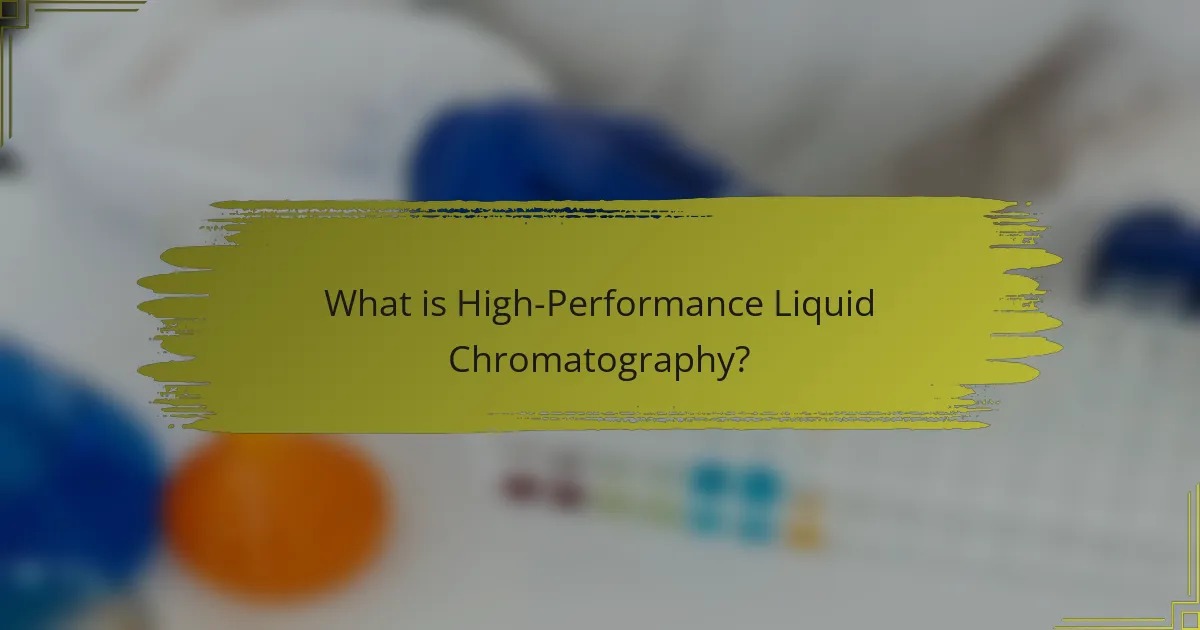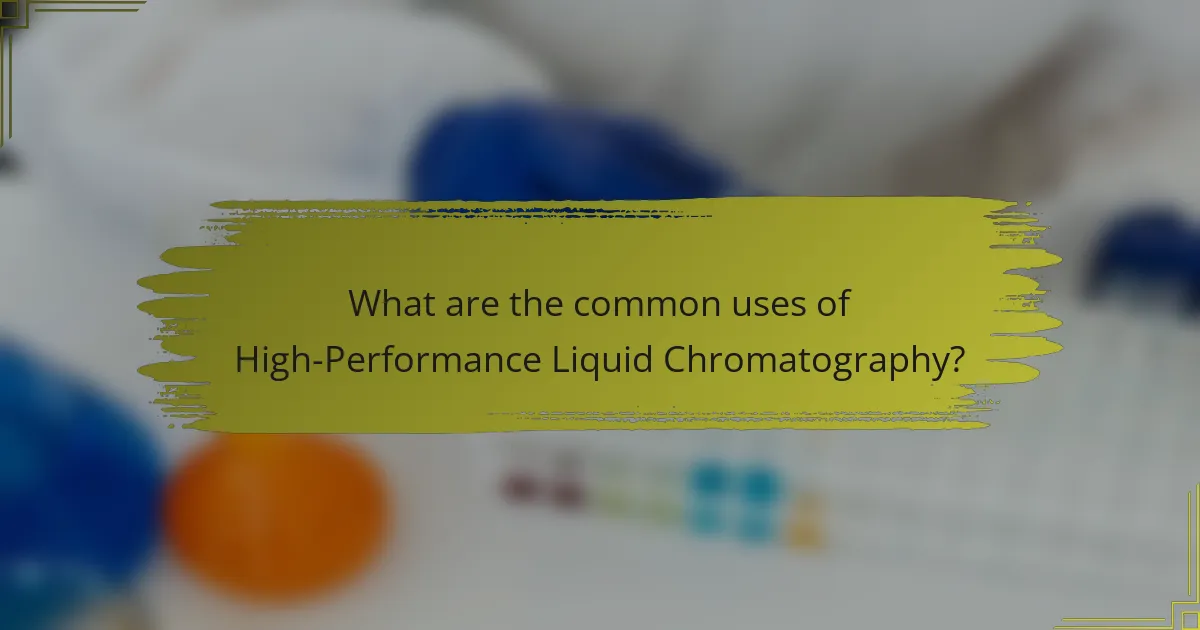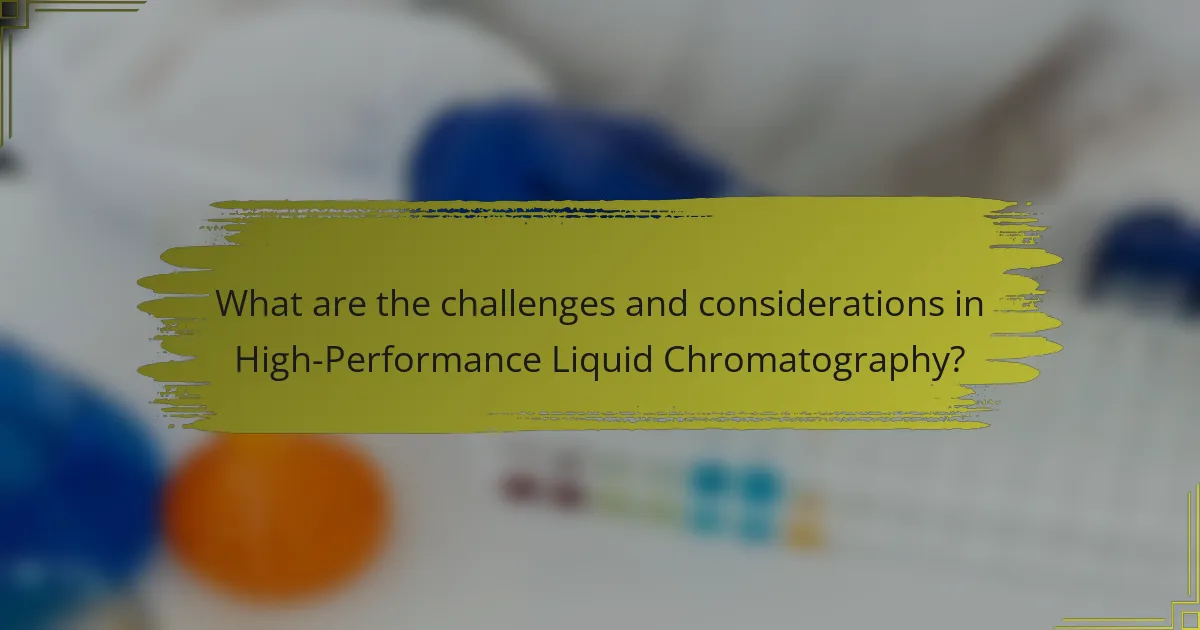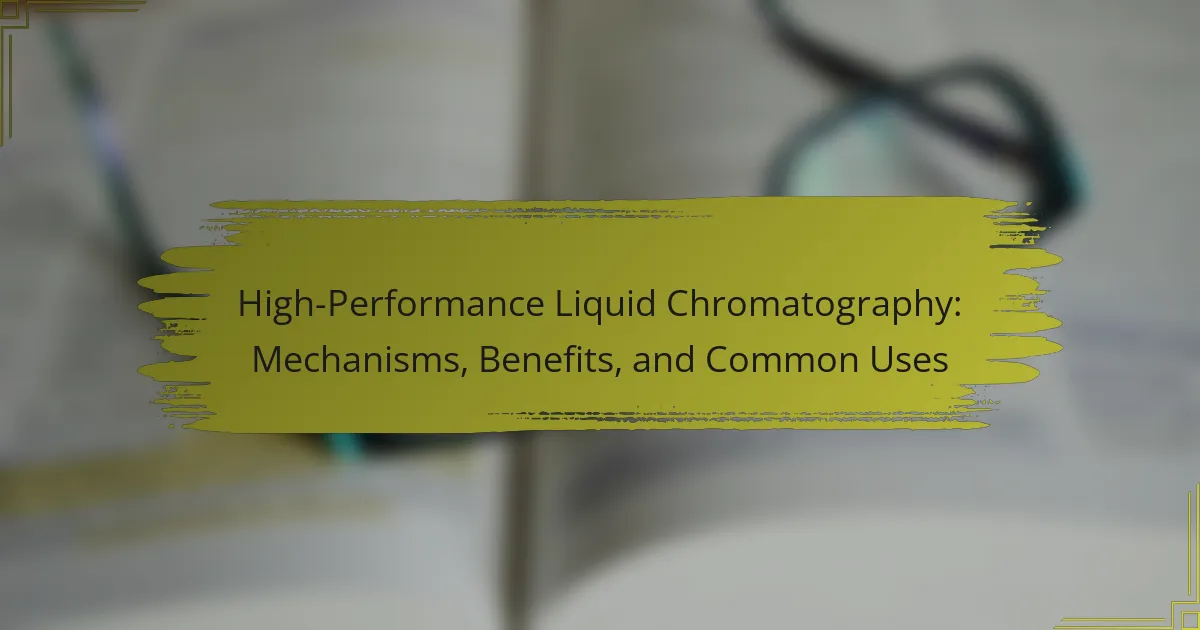
What is High-Performance Liquid Chromatography?
High-Performance Liquid Chromatography (HPLC) is an analytical technique used to separate, identify, and quantify components in a mixture. HPLC utilizes high pressure to push solvents through a column packed with stationary phase material. This process enables the separation of compounds based on their interactions with the stationary phase and the mobile phase. HPLC is widely used in pharmaceuticals, environmental testing, and food analysis. It provides high resolution and sensitivity, making it suitable for complex mixtures. The technique can analyze various substances, including small molecules and large biomolecules. HPLC has become a standard method in laboratories for quality control and research applications.
How does High-Performance Liquid Chromatography work?
High-Performance Liquid Chromatography (HPLC) works by passing a liquid sample through a column packed with solid adsorbent material. The sample components separate based on their interactions with the stationary phase and the mobile phase. The mobile phase is a solvent or mixture of solvents that carries the sample through the column. Different compounds in the sample interact differently with the stationary phase, leading to varied retention times. As the sample exits the column, a detector measures the concentration of each component. This process allows for precise identification and quantification of substances in the mixture. HPLC is widely used in pharmaceuticals, environmental testing, and food safety analysis due to its accuracy and efficiency.
What are the key components of High-Performance Liquid Chromatography?
The key components of High-Performance Liquid Chromatography (HPLC) include the solvent delivery system, injector, column, detector, and data analysis system. The solvent delivery system pumps the mobile phase at a controlled flow rate. The injector introduces the sample into the mobile phase stream. The column contains stationary phase material where separation occurs. The detector identifies and quantifies the separated components as they elute from the column. The data analysis system processes the signals from the detector to generate chromatograms. These components work together to achieve efficient separation and analysis of compounds in various samples.
How do the components interact in the chromatography process?
In chromatography, components interact through differential partitioning between stationary and mobile phases. The stationary phase is a solid or liquid that remains fixed in place. The mobile phase is a liquid or gas that flows through the stationary phase. As the mobile phase moves, different components of the mixture travel at varying rates. This variation is due to differences in solubility and adsorption to the stationary phase. Components that are more soluble in the mobile phase move faster. Conversely, components that have a stronger affinity for the stationary phase move slower. This interaction results in the separation of components along the chromatographic medium. The effectiveness of this separation is influenced by factors such as temperature, flow rate, and the chemical properties of the components involved.
What are the main mechanisms of High-Performance Liquid Chromatography?
High-Performance Liquid Chromatography (HPLC) operates primarily through three main mechanisms: adsorption, partition, and size exclusion. Adsorption involves the interaction between the stationary phase and analytes, leading to separation based on polarity. In partition chromatography, analytes distribute between two liquid phases, enhancing separation based on solubility. Size exclusion chromatography separates molecules based on their size, allowing larger molecules to elute first. Each mechanism contributes to the overall efficiency and resolution of HPLC, enabling precise analysis of complex mixtures.
How does the mobile phase influence separation in High-Performance Liquid Chromatography?
The mobile phase significantly influences separation in High-Performance Liquid Chromatography (HPLC). It determines the interaction between the analytes and the stationary phase. The choice of solvents affects the solubility of compounds. Different polarities in the mobile phase can lead to varying retention times. A more polar mobile phase can enhance the elution of polar compounds. Conversely, a less polar mobile phase favors non-polar compounds. Flow rate of the mobile phase also impacts separation efficiency. Optimal flow rates reduce band broadening and improve resolution. Adjusting the mobile phase composition allows for fine-tuning of separation characteristics.
What role does the stationary phase play in High-Performance Liquid Chromatography?
The stationary phase in High-Performance Liquid Chromatography (HPLC) is crucial for separating components in a mixture. It provides a surface for analytes to interact based on their chemical properties. The stationary phase can be polar or non-polar, influencing the retention time of different compounds. This interaction allows for differential migration of substances through the column. The effectiveness of separation is determined by the choice of stationary phase material. Common materials include silica gel and polymer-based phases. These materials facilitate various separation mechanisms, such as adsorption and partitioning. The role of the stationary phase is essential for achieving high resolution and sensitivity in HPLC analyses.
What benefits does High-Performance Liquid Chromatography provide?
High-Performance Liquid Chromatography (HPLC) offers several key benefits. It provides high resolution and sensitivity for separating complex mixtures. HPLC can analyze samples quickly, often within minutes. This technique allows for the quantification of components at low concentrations. It is versatile and can be used for various substances, including pharmaceuticals and environmental samples. HPLC is also reproducible, ensuring consistent results across multiple analyses. Furthermore, it requires minimal sample preparation, saving time and resources. The method is widely accepted in regulatory environments, enhancing its credibility in scientific research.
How does High-Performance Liquid Chromatography enhance analytical precision?
High-Performance Liquid Chromatography (HPLC) enhances analytical precision through its ability to separate compounds with high resolution. This technique utilizes high pressure to push solvents through a column packed with stationary phase material. The precise control of flow rates and temperature contributes to consistent results. HPLC systems can detect minute differences between compounds, improving accuracy in quantification. Furthermore, advanced detectors such as UV, fluorescence, and mass spectrometry provide sensitive measurements. Studies show that HPLC can achieve reproducibility with a relative standard deviation of less than 1%. This level of precision is crucial in fields like pharmaceuticals and environmental testing.
What are the cost-effectiveness advantages of using High-Performance Liquid Chromatography?
High-Performance Liquid Chromatography (HPLC) offers significant cost-effectiveness advantages. It allows for rapid analysis, reducing time and labor costs in laboratories. HPLC requires smaller sample volumes, which lowers the amount of reagents needed. This method also minimizes waste, leading to further cost savings. The high precision and accuracy reduce the need for repeat tests, saving additional resources. HPLC systems can handle multiple samples simultaneously, enhancing throughput. According to a study published in the Journal of Chromatography A, HPLC can achieve cost savings of up to 30% compared to traditional methods. These factors combined make HPLC a financially viable choice for analytical laboratories.

What are the common uses of High-Performance Liquid Chromatography?
High-Performance Liquid Chromatography (HPLC) is commonly used for separating, identifying, and quantifying compounds in various samples. It is widely applied in pharmaceutical analysis to ensure the purity and concentration of active ingredients. HPLC is also utilized in environmental testing to detect pollutants in water and soil samples. In food and beverage industries, it helps analyze additives, contaminants, and nutritional content. Additionally, HPLC plays a crucial role in biochemical research for protein and peptide analysis. Its versatility makes it essential in clinical diagnostics for analyzing biological fluids.
In which industries is High-Performance Liquid Chromatography widely applied?
High-Performance Liquid Chromatography (HPLC) is widely applied in the pharmaceutical, biotechnology, food and beverage, environmental testing, and chemical industries. In pharmaceuticals, HPLC is crucial for drug formulation and quality control. Biotechnology utilizes HPLC for protein purification and analysis. In the food and beverage industry, HPLC ensures safety and quality by analyzing additives and contaminants. Environmental testing relies on HPLC for detecting pollutants in water and soil samples. The chemical industry uses HPLC for product development and quality assurance. Each of these industries benefits from HPLC’s precision and reliability in separation and analysis.
How is High-Performance Liquid Chromatography utilized in pharmaceuticals?
High-Performance Liquid Chromatography (HPLC) is utilized in pharmaceuticals for analyzing and purifying compounds. HPLC helps in determining the purity of active pharmaceutical ingredients (APIs). It also assists in identifying impurities and degradation products. The method is essential for quality control in drug manufacturing. HPLC is employed in the formulation development process to optimize drug compositions. It provides quantitative analysis of drug substances in biological samples. Regulatory agencies require HPLC data for drug approval. The technique ensures compliance with safety and efficacy standards in pharmaceuticals.
What are the applications of High-Performance Liquid Chromatography in environmental analysis?
High-Performance Liquid Chromatography (HPLC) is widely used in environmental analysis. It helps in detecting pollutants in water, soil, and air samples. HPLC is effective for analyzing pesticides and herbicides. It can quantify heavy metals in environmental samples as well. Additionally, HPLC is used for monitoring pharmaceuticals in wastewater. This technique allows for the separation of complex mixtures. Its sensitivity enables the detection of trace contaminants. HPLC is essential for ensuring compliance with environmental regulations.
What are some specific examples of High-Performance Liquid Chromatography applications?
High-Performance Liquid Chromatography (HPLC) is widely used in various fields. One application is in pharmaceuticals for drug formulation analysis. HPLC ensures purity and dosage accuracy in medications. Another application is in environmental testing to detect pollutants in water samples. HPLC can identify and quantify contaminants effectively. Additionally, HPLC is used in food and beverage industries for quality control. It analyzes additives and nutrients in products. In clinical laboratories, HPLC measures biomolecules in blood samples. This application aids in diagnosing diseases. Lastly, HPLC is utilized in research for separating complex mixtures. It plays a crucial role in developing new compounds.
How does High-Performance Liquid Chromatography assist in food safety testing?
High-Performance Liquid Chromatography (HPLC) assists in food safety testing by providing precise separation and analysis of food components. HPLC detects contaminants, additives, and toxins in food samples. It achieves high sensitivity and specificity, making it suitable for detecting low concentrations of harmful substances. The technique can identify pesticides, heavy metals, and mycotoxins effectively. According to a study published in the Journal of Agricultural and Food Chemistry, HPLC can quantify pesticide residues at levels as low as 0.01 mg/kg. This capability ensures compliance with safety regulations and protects consumer health. Thus, HPLC is essential for maintaining food safety standards.
What role does High-Performance Liquid Chromatography play in clinical diagnostics?
High-Performance Liquid Chromatography (HPLC) is essential in clinical diagnostics for analyzing biological samples. It allows for the precise separation of compounds, which is critical for accurate diagnosis. HPLC is used to measure drug levels, hormones, and metabolites in patient samples. This technique ensures high sensitivity and specificity, allowing for the detection of low concentrations of substances. For example, HPLC can identify therapeutic drug monitoring in patients with chronic conditions. The ability to provide rapid results enhances patient care and treatment decisions. Overall, HPLC plays a pivotal role in ensuring reliable diagnostic outcomes in clinical settings.

What are the challenges and considerations in High-Performance Liquid Chromatography?
High-Performance Liquid Chromatography (HPLC) faces several challenges and considerations. One major challenge is the need for precise calibration. Accurate results depend on well-calibrated equipment. Another consideration is the choice of solvents. Solvent compatibility affects the separation process. Column selection is also critical. The wrong column can lead to poor resolution. Additionally, sample preparation poses challenges. Contaminants can interfere with analysis results. Temperature control is essential for reproducibility. Variations in temperature can alter retention times. Lastly, maintenance of the HPLC system is crucial. Regular maintenance prevents performance degradation.
What common issues can arise during High-Performance Liquid Chromatography analysis?
Common issues during High-Performance Liquid Chromatography (HPLC) analysis include baseline noise, peak tailing, and pressure fluctuations. Baseline noise can result from detector sensitivity or mobile phase impurities. Peak tailing often occurs due to column overload or improper pH levels. Pressure fluctuations may arise from blockages in the system or pump malfunctions. Additionally, sample degradation can lead to inconsistent results. These issues can compromise the accuracy and reliability of the analysis. Regular maintenance and calibration of the HPLC system can help mitigate these problems.
How can sample preparation impact High-Performance Liquid Chromatography results?
Sample preparation significantly impacts High-Performance Liquid Chromatography (HPLC) results. Proper sample preparation ensures the removal of impurities and matrix effects. This enhances the accuracy and precision of the analysis. Inadequate preparation can lead to poor resolution and inaccurate quantification. For instance, sample filtration can prevent clogging of the HPLC column. Moreover, the choice of solvent can influence the retention time of analytes. A study by Huber et al. (2019) demonstrated that optimized sample preparation improved detection limits by 30%. Thus, meticulous sample preparation is crucial for reliable HPLC outcomes.
What are the troubleshooting steps for common High-Performance Liquid Chromatography problems?
Check the solvent delivery system for leaks or blockages. Ensure the pump is functioning correctly. Verify that the mobile phase is prepared properly and degassed. Inspect the column for damage or contamination. Confirm that the detector is calibrated and functioning. Adjust the flow rate if necessary. Review the sample preparation process for consistency. Monitor the system for air bubbles in the lines.
What are best practices for optimizing High-Performance Liquid Chromatography results?
To optimize High-Performance Liquid Chromatography (HPLC) results, ensure proper calibration of the instrument. Regular calibration improves accuracy and precision. Use freshly prepared mobile phases to prevent degradation. This maintains consistency in separation. Optimize flow rates based on the specific application. Adjusting flow rates can enhance resolution and reduce analysis time. Maintain a consistent temperature during analysis. Temperature fluctuations can affect retention times. Ensure proper sample preparation to minimize contamination. Clean samples lead to more reliable results. Regularly maintain and clean the HPLC system. This prevents blockages and ensures optimal performance. Finally, use appropriate column selection based on the analyte characteristics. The right column enhances separation efficiency and peak resolution.
How can method development improve High-Performance Liquid Chromatography outcomes?
Method development enhances High-Performance Liquid Chromatography (HPLC) outcomes by optimizing separation efficiency and accuracy. Tailoring parameters such as mobile phase composition, flow rate, and temperature leads to improved resolution of analytes. Fine-tuning these variables can minimize retention time and enhance peak shape. Additionally, method development ensures reproducibility and reliability across different instruments and conditions. This process also aids in identifying potential interferences and optimizing detection limits. Studies indicate that well-developed methods can increase sensitivity by up to 50%. Overall, method development is crucial for achieving precise and reliable results in HPLC applications.
What tips can enhance the efficiency of High-Performance Liquid Chromatography processes?
Optimize the mobile phase composition for better separation. Adjusting the solvent strength can enhance resolution and peak shape. Maintain consistent temperature throughout the process. Temperature fluctuations can lead to variability in retention times. Regularly calibrate and maintain the HPLC system. This ensures accurate flow rates and pressure settings. Use appropriate column dimensions for the specific application. A shorter column can reduce analysis time without sacrificing resolution. Implement a proper sample preparation method. This minimizes matrix effects and improves reproducibility. Monitor system performance regularly with quality control samples. This helps identify any deviations early on.
High-Performance Liquid Chromatography (HPLC) is an analytical technique essential for the separation, identification, and quantification of components in various mixtures. The article provides an overview of HPLC’s mechanisms, including adsorption, partition, and size exclusion, as well as its key components such as the solvent delivery system, injector, column, and detector. It highlights the significant benefits of HPLC, including high resolution, sensitivity, and cost-effectiveness, while also addressing its applications across industries such as pharmaceuticals, environmental testing, and food safety. Additionally, the article discusses common challenges, best practices, and the importance of method development for optimizing HPLC outcomes.
